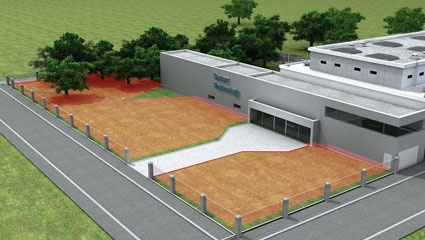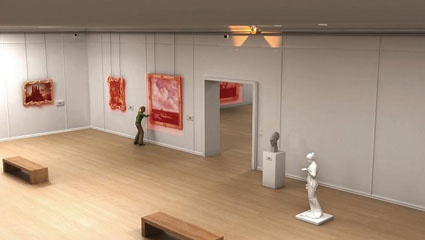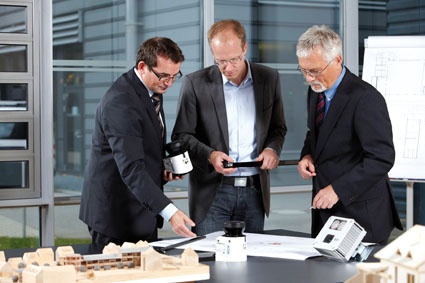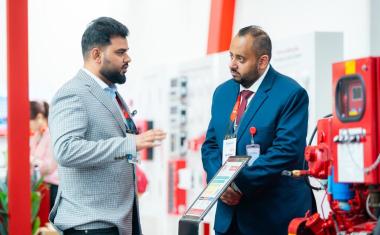Lasers in Security
Protecting persons, securing valuables, preventing (or at least the early detection of) crime, electrical and electronic systems for secure building automation are increasingly gai...





Protecting persons, securing valuables, preventing (or at least the early detection of) crime, electrical and electronic systems for secure building automation are increasingly gaining in importance. The technological solutions are correspondingly innovative. Matthias Mezger, Manager of Marketing and Sales Building Automation at Sick, takes a look at the developments in the use of lasers for intrusion detection.
An efficient coordinated combination of mechanical, structural, organizational and intrusion signaling measures is necessary in order to effectively protect objects in public, industrial, commercial or residential buildings from criminal activities. Peter Fasold, Detective Chief Superintendent in Bavaria's State Office of Criminal Investigation and responsible for crime prevention, clarifies the importance of coordinating all protective measures: "Intruder Alarm Systems must be coupled as efficiently as possible with the mechanical security equipment so that perpetrators are prevented from completing their intended action until the authorities alerted by the intruder alarm system can reach the scene of the crime."
Electrical and electronic systems, however, are not only important constituents of effective protection against break-ins, but also take on tasks in the automation of buildings and ensure safe operating processes. Electronic people-counting systems, whose information can be used for controlling air-conditioning or evacuating buildings, are increasingly being employed to detect individual persons, flows of people and the direction of movement in shopping malls, at airports or at exhibition grounds, for example.
Outside In
Reliable monitoring against break-ins, theft and vandalism generally already begins on the grounds around the building to be protected. Typical tasks working from the outside inwards include monitoring perimeters, fences and walls and the detection, camera guidance and tracking of persons or objects on open ground. Then attention must be paid to securing facades and roofs, monitoring ceilings and preventing breaches above ground level. Finally monitoring doors, gates and paths and protecting individual objects such as paintings or other exhibits in museums and art galleries must complete the security concept.
Despite the wide variety of these tasks, the technology of the measuring laser scanner has successfully established itself as an innovative solution approach. Peter Fasold confirms this from his experience: "Laser scanners are highly suitable for area monitoring, both indoors and outdoors. They offer flexible adaptation of the monitored field as well as the provision of signals and alarms. Spurious and false alarms are virtually ruled out by intelligent electronic evaluation. Moreover, they are proof against vandalism, sabotage and tampering, and require minimum installation effort as a result of their single-device design."
High Security
Whether security equipment for reporting break-ins or solutions for safety management, Sick's product portfolio offers a wide range of sensor solutions for both areas (some of which are VdS and TUV certified), as well as the corresponding application-related consulting expertise. A good example of this is the new LMC 12x from Sick; it is the world's first area laser scanner to be granted Class C certification by the Association of German Insurers, and thus also recommended by the police.
The proof of their reliability is demonstrated by the several hundred laser scanners of differing types that are already used to monitor nuclear sites and that have made Sick the market leader in this field. Peter Fasold confirms the suitability of the systems: "The TÜV's approval for [their use at] nuclear plants was applied for and granted as long ago as 2004." Laser scanners, however, are also increasingly being used for other tasks and in other surroundings, for example to monitor walls in galleries or museums. Sick has consequently developed a unique laser scanner solution to protect exhibits, indoor areas and corridors as well as to monitor ceilings.
Meets the Mark
The LMC12x laser scanner is a measurement system specially adapted for use as an intruder alarm system. This solution was the world's first system to be certified in Class C by the VdS Schadenverhütung GmbH in line with Guideline No. 2117 and applying test method VdS 2485 in order to confirm its suitability for use as an intruder alarm system as required by insurance companies. The unit not only offers increased response sensitivity and detection accuracy, but also enhanced protection (such as integrated sabotage protection) against attempts to defeat it in an active or inactive state. Class C is the most demanding approval standard and is recognized throughout Europe by national certification organizations, or at least used as a basis. In this connection, for both installers and users, it is important to mention that the associated mounting set for the LMC12x (for mounting the scanner) also meets the demands of VdS Guideline 2312, so that mechanical tampering can also be ruled out.
The LMC12x was designed for use indoors and is in Environment Class II according to VdS 2110. Sick's product portfolio includes other indoor scanners which, depending on the necessary range, resolution, scanning angle or response times, provide optimum solutions for various applications. The laser scanners are supplemented by vision systems and light grids with which windows, duct openings or skylights can be optimally monitored. A variety of laser scanners and photoelectric switches are also available for outdoor use. These will soon be supplemented by the LMC13x, which will meet the VdS Environmental Class IVa.
Efficiency and Security Management
In addition to sensors for detecting burglaries and signaling alarms, solutions for optimizing processes and maintaining organizational security regulations are increasingly coming to the fore in building automation. Almost all applications involve the detection and counting of persons as well as the detection of the direction of motion of both individuals and crowd flows. This information is necessary, amongst other things, for energy-optimized control of heating, air conditioning and ventilation equipment; the temporary closure of overcrowded areas, floors or parking levels; the organization of evacuation measures as well as for marketing and logistical purposes.
Depending on the task and installation conditions, a range of sensor technologies (such as ultrasonic sensors, photoelectric switches and photoelectric proximity switches, light grids, vision sensors, bar code readers and, of course, laser scanners) are suitable for such people detecting and counting applications. With these devices, Sick's product portfolio provides great potential for efficient and high-availability building automation, such as for access control, monitoring doors, gates and paths, for counting persons or for singling out persons or vehicles in single-entry access control gates.
With its range of monitoring and signaling sensors for building security, and its control and regulatory solutions for facility information management, Sick can meet numerous tasks in building automation from a single source. These are supplemented by the comprehensive technology and implementation expertise available to the company's end-customers, users, installers, system integrators and other security companies within the framework of non-binding application-related support. This ranges from manufacturer-neutral tendering, through project planning up to after-sales service for Sick products. These all result in efficient solutions for building security and monitoring-relevant operational processes with high availability, providing long-term investment protection.
most read

Machine & plant safety: The winners of category A at the GIT SECURITY AWARD 2026
GIT SECURITY AWARD 2026: Machine & plant safety - an overview of the most innovative solutions


The Benefits of AI-based Video Surveillance Solutions for Sports Venues
Dallmeier Interview: Artificial intelligence Makes Stadiums Smarter

Intersec Saudi Arabia 2025 Concludes With Record Exhibitor Participation and Strong Industry Engagement
The seventh edition of Intersec Saudi Arabia showcased 434 exhibitors from 40 countries and welcomed 23,894 attendees









